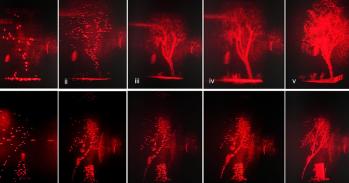
Each year more than a million avalanches fall worldwide, killing around a hundred people in the Alps alone. Can mathematical models be used to predict and prevent these disasters?
Each year more than a million avalanches fall worldwide, killing around a hundred people in the Alps alone. Can mathematical models be used to predict and prevent these disasters?
The aim now is to use these models for designing defensive avalanche structures such as dams or snow sheds
Dr McElwaine
Dr Jim McElwaine, in the Department of Applied Mathematics and Theoretical Physics, is interested in developing such models. He has recently returned from a three-month trip to the Swiss Federal Institute for Snow and Avalanche Research in Davos, where he has been validating his models using real avalanche situations.
Historically, the disciplines of forecasting and hazard zoning have been used in an effort to reduce the deaths and damage caused by avalanches. Both rely heavily on the historical record and the wealth of data collected over hundreds of years.
Forecasting estimates the chance of an avalanche occurring on a particular day in a particular region and is carried out by collecting weather data and information about the snowpack, and comparing it with the frequency of avalanches on similar days in the past. As avalanches tend to fall on the same track year on year but with different sizes, hazard zoning estimates how far an avalanche will travel and what damage it will cause. In the most dangerous ‘red’ zones, which are highly vulnerable to avalanches, no building is permitted.
Although these methods have proved very successful in the Alps, there have been rare but disastrous occasions where they have gone wrong. In 1999, the worst avalanche winter in the Alps for 20 years, an ‘Alpine Tsunami’ travelling at over 100 mph entered the safe ‘green’ zone of the Austrian village of Galtür, killing 31 people. ‘These methods are becoming increasingly uncertain for the Alps as the climate changes and past statistics stop being useful,’ explains Dr McElwaine, ‘and, in countries like Turkey and Iran, where fewer data are available, bad accidents frequently devastate villages.’
Where data are scant, or where the past record can no longer be relied upon, predictive models are necessary. To do this, Dr McElwaine has designed and installed sensors in the Swiss test site Vallée de la Sionne. Powder snow avalanches are triggered by dropping explosive charges from a helicopter. The speed of the air in front of, and inside, the very largest avalanches are then measured and compared with mathematical models. ‘The data from these experiments confirmed our model,’ says Dr McElwaine, ‘and showed how natural avalanches can indeed be related to laboratory experiments. The aim now is to use these models for designing defensive avalanche structures such as dams or snow sheds.’
This research was supported by the Royal Society. For more information, please contact Dr Jim McElwaine (jnm11@amtp.cam.ac.uk).
This work is licensed under a Creative Commons Licence. If you use this content on your site please link back to this page.





